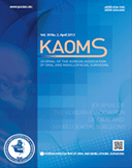Journal of the Korean Association of Oral and Maxillofacial Surgeons
- P-ISSN2234-7550
- E-ISSN2234-5930
- SCOPUS, KCI, ESCI
 ISSN : 2234-7550
ISSN : 2234-7550
Intraoral HIV-associated Burkitt’s lymphoma: a rare case report with special emphasis on differential diagnosisIntraoral diagnosis
Uma Datar (Bharati Vidyapeeth (Deemed to be University) Dental College and Hospital)
Sampada Kanitkar (Private Clinic, Sangli, India)
Sanjay Byakodi (Bharati Vidyapeeth (Deemed to be University) Dental College and Hospital)
Abstract
Individuals with human immunodeficiency virus (HIV) infection present with unique intraoral manifestations of various neoplasms. Intraoral HIV-associated Burkitt’s lymphoma is a rare presentation, especially in patients of Indian origin and may present as an initial sign of HIV. The objective of this paper is to report a rare case of Burkitt’s lymphoma in an HIV-positive Indian patient along with a special emphasis on differential diagnosis. A 30-year-old Indian female presented with a solitary, well-defined, exophytic mass extending anteroposteriorly and buccolingually from the 35th to 38th regions with no evidence of intraosseous extension. An incisional biopsy was performed, and histopathology showed sheets of neoplastic lymphoid cells with numerous tingible body macrophages with clear cytoplasm, presenting a starry sky appearance, suggesting a diagnosis of BL. The tumor cells were positive for CD10, CD20, c-myc, and Epstein–Barr virus, with a nearly 100% Ki-67 proliferative index. The patient tested positive for HIV. This report indicates the importance of immunohistochemical analysis to differentiate Burkitt’s lymphoma from other similar lesions like diffuse large B-cell lymphoma. Thorough knowledge of the clinical presentation, etiopathogenesis, histopathology, and immunoprofile of intraoral HIV-associated Burkitt’s lymphoma is essential among clinicians and pathologists.
- keywords
- Aquired immunodeficiency syndrome, Burkitt lymphoma, Gingiva, HIV, Oral cavity
- 다운로드 수
- 조회수
- 0KCI 피인용수
- 0WOS 피인용수